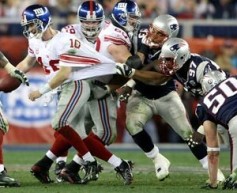TV Triumphant: Super Bowl XLII Puts Broadcast Back on Top

Ninety-seven and one-half million viewers watched the Super Bowl on Fox this past Sunday. It looks like broadcast television can still hold its own, despite the rising tide of media options and industry opinion that increasingly equates the word "broadcast" with "bone yard."
Ninety-seven and one-half million viewers. That's the biggest audience ever for a Super Bowl telecast. One must go all the way back to the dark and digitally devoid year of 1996 to find the previous Super Bowl viewer record: 94.1 million. It is also the second largest audience in television history, topped only by the reigning record-holder, the series finale of M*A*S*H back in February, 1983 (106 million viewers).
On Monday, News Corp. chief executive Rupert Murdoch declared on his Fox News Channel that Super Bowl Sunday was "the greatest day ever in the history of our network, probably any network." On that day, the 21-year-old Fox
Only at JackMyers.com: Ed Martin's TV Buzz:Exclusive Review: The Green Arrow Returns to “Smallville”!
enjoyed its largest audience ever and, Murdoch stated on FNC, "took in over $250 million in revenue." In fact, its Super Bowl telecast last week (along with the post-Bowl telecast of House, plus the Tuesday and Wednesday telecasts of American Idol) contributed to Fox enjoying its highest rated week ever among total viewers and adults 18-49.
What's behind all of this history-making during an otherwise down period for broadcast television? There was much fevered anticipation heading into the showdown between the New England Patriots and the New York Giants, but there has been huge excitement for dozens of Super Bowls through the years. Was it the Patriots' shot at a perfect season including a Super Bowl win, the first since the Miami Dolphins in 1972? Was it the star power of Patriots quarterback and magazine cover boy Tom Brady? Was it the pre-Bowl buzz for the all-important commercials that would debut during the game, many of them previewed to favorable response on a number of Internet sites? Was it the fact that more people seem to be watching sports during this winter of our discontent, when so much of the television programming we take for granted at this time of year is missing because of the WGA strike?
I'm guessing it is all of the above, plus one giant additional factor: The rise of digital cable and satellite reception and high-definition television. High-def goes a long way toward making sports on television a mesmerizing viewing experience, even for people who don't give a fig about football.
This is all glorious news for those of us who still value television and find ourselves increasingly defensive amid the rising tide of rabid broadcast bashers and Internet enthusiasts. Lately it has seemed that various factions within the media business are out to kill television, at least as it is enjoyed in the traditional sense, so blind is their manic enthusiasm for all things Web and phone related.
SB XLII MVP Eli Manning and the rest of the Giants weren't the only winners on Sunday. Television was a champion, as well. So was the growing synergy between television and the Internet, as we saw with the huge success that sites such as Hulu, Firebrand and many, many others enjoyed before, during and after the game with their displays of Super Bowl commercials.
Which brings up another success story of note this week, though it happens on an annual basis: The triumph of the television commercial.
You can't go anywhere these days without hearing people complain about commercials. (I suspect they are really griping about network promos, which remain out of control, rather than advertiser spots.) Millions of people have embraced their DVRs of choice (and the monthly fees that go with them) without hesitation, as much to eliminate commercials from their television experience as to record programming for more convenient viewing. (Some of us welcome commercial breaks as a time to channel surf, but that's another story.) Meanwhile, it seems there isn't a media executive in New York or Los Angeles who doesn't sing the praises of DVRs and Internet viewing, both of them the enemy of the innocent television commercial.
But come the Super Bowl and everybody everywhere is suddenly talking about ads on TV! Indeed, people don't simply watch commercials during the big game – they hop online to watch them in advance of the game, or to watch them again after the telecast. (I would have done that to enjoy the cinematic Coca-Cola Parade Balloons spot again even if I didn't write about programming for a living.) And they also happily weigh in as critics of same, mostly in online polls and contests built around Bowl spots. They talk about them. They argue about them. They care about them. Not all of the commercials that debut during the Super Bowl are critical or audience favorites, but they all benefit from the halo effect of the event.
All that said, by the time you read this commercials will have fallen out of favor again and people will have returned to the everyday behavior of putting them down and/or doing all they can to avoid them.
This is ridiculous. There is no reason why commercials cannot enjoy similarly significant popularity throughout the year – especially now that they are growing in popularity as Web content. (Just try to not lose track of time on Firebrand, where you can browse through hundreds of cool commercials at your leisure.) Advertisers simply must work harder to create and implement eye-catching campaigns and to integrate them with other media. They should treat every week as Super Bowl week – or at least look at every month as if it were the February sweeps period, when the Super Bowl is televised.


